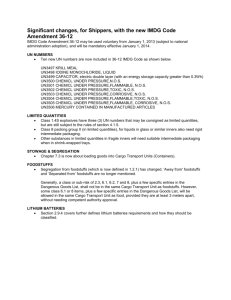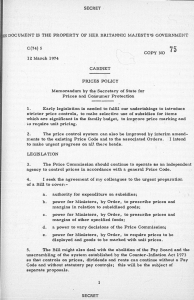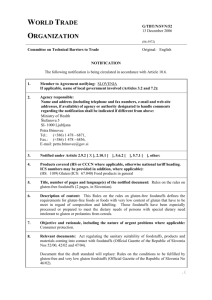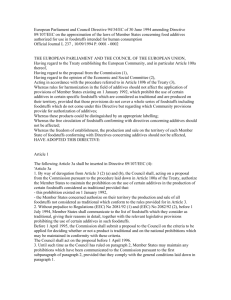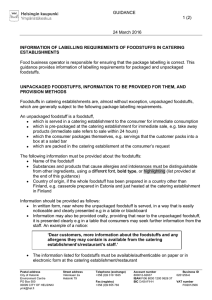general information brief concerning the regulation of materials and
advertisement
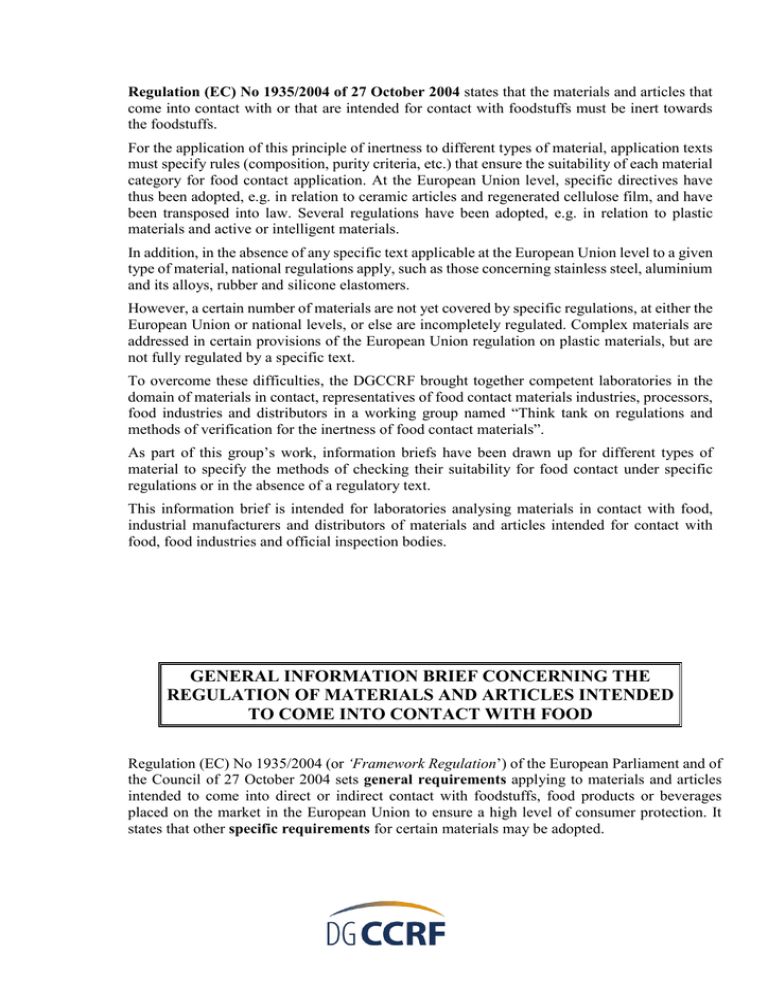
Regulation (EC) No 1935/2004 of 27 October 2004 states that the materials and articles that come into contact with or that are intended for contact with foodstuffs must be inert towards the foodstuffs. For the application of this principle of inertness to different types of material, application texts must specify rules (composition, purity criteria, etc.) that ensure the suitability of each material category for food contact application. At the European Union level, specific directives have thus been adopted, e.g. in relation to ceramic articles and regenerated cellulose film, and have been transposed into law. Several regulations have been adopted, e.g. in relation to plastic materials and active or intelligent materials. In addition, in the absence of any specific text applicable at the European Union level to a given type of material, national regulations apply, such as those concerning stainless steel, aluminium and its alloys, rubber and silicone elastomers. However, a certain number of materials are not yet covered by specific regulations, at either the European Union or national levels, or else are incompletely regulated. Complex materials are addressed in certain provisions of the European Union regulation on plastic materials, but are not fully regulated by a specific text. To overcome these difficulties, the DGCCRF brought together competent laboratories in the domain of materials in contact, representatives of food contact materials industries, processors, food industries and distributors in a working group named “Think tank on regulations and methods of verification for the inertness of food contact materials”. As part of this group’s work, information briefs have been drawn up for different types of material to specify the methods of checking their suitability for food contact under specific regulations or in the absence of a regulatory text. This information brief is intended for laboratories analysing materials in contact with food, industrial manufacturers and distributors of materials and articles intended for contact with food, food industries and official inspection bodies. GENERAL INFORMATION BRIEF CONCERNING THE REGULATION OF MATERIALS AND ARTICLES INTENDED TO COME INTO CONTACT WITH FOOD Regulation (EC) No 1935/2004 (or ‘Framework Regulation’) of the European Parliament and of the Council of 27 October 2004 sets general requirements applying to materials and articles intended to come into direct or indirect contact with foodstuffs, food products or beverages placed on the market in the European Union to ensure a high level of consumer protection. It states that other specific requirements for certain materials may be adopted. 1. SCOPE OF THE FRAMEWORK REGULATION The text applies to materials and articles, including active and intelligent materials: intended to come into contact with food. or already in contact with food and intended for that purpose. or that can reasonably be expected to come into contact with food or to transfer their constituents to food.1 By food (or foodstuffs) is meant food as defined in Article 2 of Regulation (EC) No 178/2002. The text does not apply to materials or articles that are not intended to come into contact with foodstuffs under normal or foreseeable conditions of use , e.g. floor, ceiling and wall coverings, shelves and tables,2 automobile dashboards, aprons,3 tablecloths and place mats,4 inside walls of refrigerators (except for bins), check-out conveyor belts, meal trays,5 etc. Unwrapped foods must not be placed in direct contact with floor, ceiling or wall coverings, shelves or tables not intended for that purpose, check-out conveyors, etc. For these applications, and more generally for equipment, worktops and surfaces intended for contact with foodstuffs, food operators must make sure in particular that the general hygiene provisions in Regulation (EC) No 852/2004 (and in particular in Annex II thereto) are complied with so that these items are not a source of contamination. The materials and articles covered by the provisions of the regulation are: Packing and packaging of foodstuffs including containers, boxes, bottles, film, paper, etc. used to protect or conserve foodstuffs (including kitchen wrapping). Tableware and crockery, kitchen utensils and parts of electrical kitchen appliances intended to come into direct contact with foodstuffs (bowls, various containers, etc.). Feeding bottles and baby bottle teats, cups, etc. Machinery and equipment used for the production, processing, storage or transport of foodstuffs,* e.g. blenders, mincers, kneaders, extruders, cooking and deep freezing equipment, measurers, conveyers, pumps, cutting tools, fixed tanks (storage, fermentation, pasteurisation, etc.), transport tanks (tanker trucks and waggons, etc.), pipes, tubes and fittings, etc. * The food areas of machineries and equipment must comply with the rules for materials intended for contact with foodstuffs. The other areas must not contaminate or spoil the foodstuffs. 1 Table napkins and kitchen paper towels are considered as reasonably likely to come into contact with foodstuffs. 2 Except when these surfaces are specifically intended to come into contact with foodstuffs. 3 Except for aprons specifically intended for handling foodstuffs in food industries. 4 In particular, paper place mats must not come into contact with foodstuffs likely to be eaten. 5 The text does, however, apply to recessed trays specifically designed to hold foodstuffs. 2/13 In case of doubt, the French version shall prevail. Active materials (e.g. absorbers for moisture, gases: ethylene, oxygen, etc., materials that deliberately release authorised substances into foodstuffs, etc.) and intelligent materials (e.g. freshness indicators). Miscellaneous articles such as labels, clips, table napkins and kitchen paper towels. The following are not subject to the provisions of the Framework Regulation: Materials and articles supplied as antiques. Covering or coating materials, such as the materials covering cheese rinds, prepared meat products or fruits, which form part of the food and may be consumed together with this food (covered by regulations for foodstuffs). Fixed public or private water supply equipment, which are covered by specific regulations. The materials and articles intended to come into contact with feed and babies’ soothers are not subject to the provisions of the Framework Regulation, but are covered by the national provisions in Decree No 92-631 of 8 July 1992. 2. REQUIREMENTS APPLICABLE TO MATERIALS 2.1 General requirements: Principle of inertness (Article 3 of Framework Regulation) Materials and articles, including active and intelligent materials and articles, shall be manufactured in compliance with good manufacturing practice so that, under normal or foreseeable conditions of use, they do not transfer their constituents to food in quantities which could: endanger human health bring about an unacceptable change in the composition of the food bring about a deterioration in the organoleptic characteristics thereof Verifications shall be based on the application of approved methods of analysis, or if no such methods exist, on internationally recognised methods, or failing that, on other appropriate methods suitable for the intended purpose. Period of validity of test reports: A maximum period of 5 years is proposed. If any changes likely to modify the inertness of the material have occurred during that period, the tests must be repeated. 2.2 Organoleptic inertness In practice, the tests are carried out by reproducing the real conditions of use with actual foodstuffs. However, tests may be carried out using simulants, in accordance with existing standards, such as ISO EN 13302 or EN 1230-2 for paper and cardboard, in particular for articles whose final destination is not known. 2.3 Special requirements: active and intelligent materials Active materials and articles intended to come into contact with foodstuffs are materials and articles intended to extend the shelf-life or to maintain or improve the condition of packaged 3/13 In case of doubt, the French version shall prevail. food. They are designed to deliberately incorporate components that would release or absorb substances into or from the packaged food or the environment surrounding the food. They should be distinguished from materials and articles which are traditionally used to release their natural ingredients into specific types of food, such as wooden barrels. Intelligent materials and articles intended to come into contact with foodstuffs are materials and articles designed to monitor the condition of packaged food or the surrounding environment. These two types of materials and articles are specifically covered by Regulation (EC) No 450/2009 of 29 May 2009. EU Guidance has been drawn up to the above regulation. 2.4 Specific requirements In order to take into account the specific technological characteristics of each type of material and article subject to the provisions of the Regulation, the restrictions and conditions of use, and the substances used to make materials and articles may be set out in specific European Union measures. These specific measures may comprise: Positive lists of authorised substances. Purity criteria applicable to some of these substances. Special conditions of use. Specific migration limits. An overall migration limit. Measures concerning oral contact. EU specific measures mainly concern the following materials: Plastic materials and articles [Regulation (EU) No 10/2011 of 14 January 2011]. Recycled plastic materials and articles[Regulation (EC) No 282/2008 of 27 March 2008]. Active and intelligent materials and articles [Regulation (EC) No 450/2009 of 29 May 2009]. Ceramics [Council Directive (84/500/EEC) of 15 October 1984]. Regenerated cellulose film [Commission Directive 2007/42/EC of 29 June 2007]. In the absence of any specific European Union measures, the Framework Regulation does not prevent Member States from maintaining or adopting national provisions, on condition that they obey the principle of mutual recognition. This principle results from the ‘Cassis de Dijon’ ruling of 20 February 1979 (case 120/78) made by the Court of Justice of the European Union (ECJ) and the Orders that followed it: any product lawfully manufactured and marketed in a Member State must in principle be available for sale in all the other Member States. Regulation (EC) No 764/2008 of the European Parliament and of the Council of 9 July 2008 lays down procedures relating to the application of this principle. The specific French national measures concern the following materials: 4/13 In case of doubt, the French version shall prevail. Rubber [Order of 9 November 1994]. Silicone elastomers [Order of 25 November 1992]. Aluminium [Order of 27 August 1987]. Stainless steel [Order of 13 January 1976]. Other specific measures are in force concerning food contact materials: Order of 27 June 1912 [packaging of foodstuffs] and Order of 15 November 1945 [measuring instruments and containers]. Order of 8 September 1999 [cleaning products for materials and articles intended to come into contact with foodstuffs, food products or beverages for human or animal consumption] and Decree No 73-138 dated 12 February 1973. Order dated 12 August 1986 [treatment by ionising radiation of materials and articles placed or intended to come into contact with foodstuffs, food products or beverages]. 2.5 Written declaration of compliance (Article 16 of the Framework Regulation) 2.5.1 In accordance with Article 16 of the Framework Regulation, the specific measures of the European Union require that the materials and articles listed in Annex I of the Framework Regulation shall be accompanied by a written declaration stating that they comply with the rules applicable to them. The purpose of this declaration is to strengthen the responsibility and coordination among the different operators so as to ensure the compliance of the materials and articles by a declaration of compliance with the applicable regulatory texts, the communication of information at different stages to allow the establishment or verification of the compliance of materials and articles (in particular, information about substances), and to ensure the safe, appropriate use of these materials and articles (in particular, information on time of contact and temperature, and type of foodstuff). The declaration of compliance with the Framework Regulation does not cover only those aspects relevant to health safety (Point a, Section 1 of Article 3), but also indicates that: The materials and articles shall be manufactured in compliance with good manufacturing practices prescribed by the Framework Regulation and the regulation on good manufacturing practice. The company implements a traceability system. The material or article does not bring about an unacceptable change in the composition of the food or a deterioration in it organoleptic properties. The declaration of compliance shall be established in such a way that the articles it covers are readily identifiable (description of articles, traceability information, references, photographs, etc.). At the European Union level, the following materials are currently concerned: plastics, recycled plastics, regenerated cellulose films, epoxy derivatives, ceramics, and active and intelligent materials. In particular: A declaration of compliance must be made available for plastic materials and articles, products from intermediate stages of their manufacturing as well as for substances intended for the manufacturing of those materials and articles at the marketing stages other than at the retail stage, 5/13 In case of doubt, the French version shall prevail. in accordance with the model given in Annex IV of Regulation (EU) No 10/2011 (Article 15 of the regulation). This declaration tells the customer that a product meets the requirements of the European Union regulations for plastics, and Regulation (EC) No 1935/2004, and gives the customer the appropriate information needed to establish or verify the product’s compliance. Ceramic articles must be accompanied by a declaration of compliance “at the various marketing stages , including retail sale but excluding delivery to the final consumer” pursuant to Article 5.1 of the Order of 7 November 1985 (as amended). The requirement to supply a written declaration for ceramic articles that have not yet come into contact with foodstuffs, including at the retail stage, serves in particular to distinguish ceramic articles intended for contact with food from those intended and used for decoration. 2.5.2 In the absence of specific measures, and pursuant to Article 16, the Framework Regulation does not prevent Member States from retaining or adopting national provisions for declarations of compliance for materials and articles not covered by harmonised measures. Article 6 of Decree No 2007-766 of 10 May 2007 amended by Decree No 2008-1469 of 30 December 2008 states that at marketing stages other than sale or free distribution to the final consumer, materials and articles intended to come into contact with foodstuffs (that are not already covered by specific European Union measures) shall be accompanied by a written declaration of compliance with the provisions of Articles 3 and 4 of the Regulation of 27 October 2004. The declaration of compliance relates to a material or article delivered by a supplier to a customer. It is issued by the business operator (natural or legal persons responsible for ensuring that the requirements of Regulation (EC) No1935/2004 are met within the business under their control) for the benefit of users in food industries (including those making direct delivery to the consumer) and distributors of materials and articles. The requirement to declare does not apply to materials and articles whose characteristics show that they are obviously meant to come into contact with foodstuffs. These materials and articles are exclusively items of tableware (plates, bowls, glasses, etc.) and containers for culinary use (dishes, salad bowls, pans, etc.) whose shape shows they are obviously intended for contact with food. The written declaration of compliance need not be physically attached to goods (delivery note, invoice, etc.) nor be sent every time a customer receives an order for the same goods. It is made available to customers in paper or electronic form, or, with the customer’s agreement, is downloadable from an Internet site, in which case it will be necessary to make sure the link to the articles covered by the declaration of compliance is clearly identifiable (description of articles, traceability information, references, photographs, etc.). The declaration of compliance shall be updated in the event of changes in regulations or other changes liable to modify the inertness of the material or the article (composition or purity of substances or materials or articles). The declaration of compliance shall be communicated without delay to the inspecting authorities on their request. 6/13 In case of doubt, the French version shall prevail. 2.6 Technical documentation (Article 16 of the Framework Regulation, specific texts, consumer code) Article 16 of the Framework Regulation states that appropriate documentation shall be made available to demonstrate the compliance of materials with the rules applicable to them. This documentation (composition of materials and articles, treatments carried out, specific migration tests, overall migration tests, organoleptic tests, calculations and other evidence of compliance, etc.) shall be made available to the competent authorities on request. This documentation may be made available to customers as a part of customer-supplier relations. The specific texts contain special requirements concerning the documentation that must be made available to demonstrate the compliance or safety of the materials and articles. See also: Consumer Code, Legislative Part – Book II – Heading I: Compliance Chapter II – General compliance requirement Art. L.212-1: Requirement to perform and provide evidence of the checks and inspections carried out. Compliance Chapter IV – Application measures Art. L 214-1: Execution measures; Subparagraphs 2 and 3 Sanctions in the event of infringement of decrees as provided for in Articles L. 214-1 and L. 214-3 and in the event of sale before the result of analysis of goods recognised as fraudulent. Consumer Code, Legislative Part – Book II – Heading II: Safety – Chapter I – Prevention of risks Art. L 221-1: General requirement for professionals to ensure the safety of products and services, requirement to inform consumers of the risks inherent to a product, requirement for the entity responsible for marketing to adopt measures that, given the characteristics of the products supplied, will allow current information to be obtained on the risks that the marketed products may present, and to plan the necessary measures to keep these risks in check. 2.7 Labelling (Article 15 of the Framework Regulation) 2.7.1 Materials and articles which are not yet in contact with food when placed on the market shall be accompanied by: (1) The words “for food contact”, or a specific indication as to their use, or the symbol prescribed by the regulations.6 The indication or symbol serve to indicate that an article that is not obviously intended for contact with food is in fact intended for contact with food. It does not automatically mean that the material or article can be used in all contact conditions (duration, temperature, foodstuff); see (2) below. Its presence is reserved for those materials and articles compliant to by Article 3 of the Framework Regulation (and Article 4 when applicable), and to specific European Union measures or, in the absence of such measures, national provisions applicable to those materials and articles. 6 Articles whose characteristics show that they are obviously intended for contact with food are exempted. 7/13 In case of doubt, the French version shall prevail. In addition, it is important to avoid confusing situations that could suggest to users that secondary outer packaging (e.g. grouping packaging) bearing the symbol is itself suitable for contact with food although it is not intended for such use. (2) If necessary, special instructions to be observed for safe and appropriate use, e.g. maximum temperature of use, conditions of use in a conventional oven or microwave oven, non-use with certain types of food, instructions for cleaning before first use, etc., The presence of multiple instructions for use (e.g. indicated on both the packaging and the article itself) that prove conflicting or contradictory must be avoided. Such multiple instructions may mislead the consumer about the usability of materials and articles, especially if they result in different conditions of use. When the case is unclear, the most restrictive conditions of use should be applied – at least as restrictive as the actual contact conditions – when verifying the compliance of these materials and articles. (3) The name (or trade name) AND address7 (or registered office) of the manufacturer, processor, or seller established in a European Union Member State. (4) Adequate labelling or identification to ensure traceability. (5) In the case of active materials or articles, information on the permitted use or uses, and other relevant information, such as the name and quantity of the substances released by the active component so as to enable food business operators to comply with the food legislation in force. The information required in Points 1 to 5 shall be conspicuous, clearly legible and indelible. Retail trade shall be prohibited if the information required under Points 1, 2 and 5 is not given in a language easily understood by purchasers. 2.7.2 Conditions of labelling according to user Labelling should support users in the safe and correct use of materials and articles. Such labelling may vary according to the user. At the retail stage, the aforementioned information shall be displayed on: a) the materials and articles or on their packaging. or b) labels affixed to the materials and articles or to their packaging. or c) a notice in the immediate vicinity of the materials and articles and clearly visible to purchasers. However, for the information specified in Section 1, Point c of Article 15 of the Framework Regulation, this option shall be open only if, for technical reasons, that information or a label bearing it cannot be affixed to the materials and articles at either the manufacturing or the marketing stage. This option shall remain exceptional given the many possible ways articles can be packaged (blister, staple, box, sachet, label, hook, bag, etc.). At the marketing stages other than the retail stage, the information specified above shall be displayed on: a) the accompanying documents. or 7 Physical address 8/13 In case of doubt, the French version shall prevail. b) the labels or packaging. or c) the materials and articles themselves. Wholesalers and trade outlets that also sell consumer products play both roles and are subject to the more stringent labelling rules. 2.7.3 At the retail stage, the labelling information must be available and accessible at the time of purchase by the consumer, and if necessary during the subsequent use of the material or article. By indicating the labelling information on the finished product as far upstream as possible, the entity responsible for marketing ensures that the consumer has effective access to this information. National provisions French regulations state provisions (Article 2 of Decree No 2007-766 of 10 May 2007 as amended) to impose visible, indelible marking on articles that are not intended for contact with foodstuffs, despite their appearance. Business operators are advised that such marking will not exempt them from the legal requirements if the article falls under Regulation (EC) No 1935/2004. Hence articles that can be reasonably expected to come into contact with foodstuffs (according to their markings, appearance and shape, sale location and sector, selling conditions, etc.) shall not be thus marked, and shall comply with the provisions of the above regulations. Examples: presentation plates, certain decorative plates, paper table place mats used in catering, etc. This is a national measure that has been notified, and for which a mutual recognition clause is planned. 2.7.4 Specific labelling for active and intelligent materials: Articles 4 and 15 of the Framework Regulation: Adequate labelling or information should support users in the safe and correct use of active materials and articles. This information concerns permitted use or uses, as well as other relevant information, such as: the names of released substances and the quantities of substances released by the active component. so as to enable food business operators who use these materials and articles to comply with any other relevant Community provisions, or in their absence, national provisions applicable to food, including the provisions on food labelling. Active and intelligent materials and articles already in contact with foodstuffs shall be labelled appropriately to enable consumers to identify inedible parts and to inform them clearly of the active or intelligent nature of the materials or articles. Food business operators shall submit a declaration of compliance to users in food industries to enable them to use active or intelligent materials or articles safely and in compliance with the regulations for foodstuffs, including the provisions concerning the labelling of foodstuffs. 9/13 In case of doubt, the French version shall prevail. Article 11 of Regulation (EC) No 450/2009 To allow identification by the consumer of non-edible parts, active or intelligent materials and articles or parts thereof shall be labelled whenever they are perceived as edible: a) with the words “DO NOT EAT”; and b) as always where technically possible, with the symbol reproduced in Annex I of the above regulation. 2.8 Traceability (Article 17 of the Framework Regulation) The traceability of materials and articles intended to come into contact with foodstuffs is ensured at all stages in order to facilitate control, the recall of defective products, consumer information, and the attribution of responsibility. With due regard to technological feasibility, business operators must have in place systems and procedures to allow identification of the businesses from which and to which materials or articles and, where appropriate, substances or products covered by the Framework Regulation and its implementing measures used in their manufacture, are supplied. This information must be made available to the competent authorities on demand. The materials and articles which are placed on the market in the Community must be identifiable by an appropriate system which allows their traceability by means of relevant labelling, documentation or information. The labelling details of Article 15 for materials not yet in contact with food shall comprise adequate labelling or identification conferring traceability on the material or article. 3. OPERATORS CONCERNED BY THE REGULATION: “MATERIALS AND ARTICLES INTENDED TO COME INTO CONTACT WITH FOODSTUFFS” Requirement to report risks Pursuant to Article L. 221-1-3 of the Consumer Code, professional operators (manufacturers, importers, distributors, etc.) must, as soon as they are themselves informed thereof, inform the competent authorities of any risks presented by products they have marketed for purchase by consumers, and state the measures they have taken to offset those risks. This requirement also applies to materials intended for contact with foodstuffs (see Notice to economic operators on the implementation of the requirement to report risks and measures taken (Official Journal of the French Republic (JORF) No 0036 of 11 February 2012) 3.2 Good manufacturing practices for materials and articles The purpose of Regulation (CE) No 2023/2006 of the European Commission of 22 December 2006 amended by Regulation (EC) No 282/2008 of 27 March 2008 on good manufacturing practices for materials and articles intended to come into contact with food, in application of Regulation No 1935/2004, is to lay down rules relating to good manufacturing practice (GMP) for the groups of materials listed in Annex I of the aforementioned Framework Regulation, and for combinations of these materials. This Regulation applies to all sectors and to all stages of manufacture, processing and distribution of materials and articles, up to but excluding the production of starting substances. 10/13 In case of doubt, the French version shall prevail. This regulation implies that all business operators should ensure quality management of their activity (quality assurance and quality control systems) adapted to their position in the supply chain. Quality assurance includes the selection of starting materials to meet preestablished specifications, guaranteeing the compliance of the material or object with the rules applicable to it. Regulation (EC) No 2023/2006 provides for the establishment and maintenance of appropriate documentation, made available to the competent authorities at their request. This documentation may contain: Traceability information, and if relevant, production records Information concerning the different manufacturing operations carried out that are relevant to ensuring the compliance or safety of the finished product. Conditions of storage and handling, in particular so as to prevent contamination by setoff. Results from the quality control system. Manufacturing formulas, specifications and purity criteria for the selected starting materials, risk analysis results, changes of supplier, etc. Conditions and results of tests on finished products. Deviations and corrective actions taken in the event of changes in the manufacturing process. Detailed rules of good manufacturing practice are appended to the regulation (printing inks, plastic recycling processes). As part of good manufacturing practice, printed surfaces*, whether or not they are overlaid with a transparent coating, must not be placed in direct contact with foodstuffs, as this practice introduces an unacceptable risk of contamination of the foodstuffs by components of the printing ink. * Surfaces of a material (paper and cardboard, plastic, etc.) marked with printing ink. This does not apply to decorations that are a structural part of the materials, having been bonded or embedded within them (e.g. by a thermal “baking” process) so as to form one single layer, or printing inks whose components are foodstuff ingredients, on condition that these components have no technological role in the packaged foodstuff (see Regulation (EC) No. 1333/2008 as amended, and Regulation (EU) No 231/2012 as amended). 3. 3 Liability of operators in the chain (chemical inertness) The economic operators (manufacturers, processors, users) are liable for the compliance of the materials and articles with Article 3 of the Framework Regulation, to the extent of the operations conducted under their supervision (manufacture, storage, transport) and according to the intended conditions of contact, or where not known, foreseeable conditions of contact. An economic operator introducing or generating a substance in a product is responsible for the compliance of that substance. This responsibility applies to impurities in the substance, and any degradation and/or decomposition products linked to the intended use that can form at this stage or at a later stage in the intended use. The compliance of materials and articles shall be demonstrated as far upstream as possible in the chain by manufacturers and processors. Economic operators shall be responsible for declaring the compliance of the materials and articles in predefined conditions: 11/13 In case of doubt, the French version shall prevail. Conditions of contact: time, temperature, type of foodstuff, type of contact (single or repeated use). If relevant: conditions of storage and transport of materials. If relevant: support, conditions of application, frequency of use, and other relevant variables, etc. When compliance cannot be declared, all the relevant information must be supplied* in relation to the next stage (composition of materials, concentration and purity of substances entering into the composition, etc.) to enable the operator downstream to carry out this task. * if necessary, as part of confidentiality agreements. Concerning professional users of materials and articles intended to come into contact with food, Section 1 of Article 17 of Regulation (EC) No 178/2002 requires food and feed business operators to verify that foodstuffs comply with the rules that are applicable to them. Subject to confidentiality requirements these operators must have access to relevant information concerning materials and articles intended for the packaging of foodstuffs, and must possess technical documentation concerning the compliance and safety of the materials and articles brought into contact with foodstuffs. Article 1 of Regulation (EC) No 852/2004 states that “the primary responsibility for food safety rests with the food business operator”, and states that the general implementation of procedures based on HACCP principles, together with the application of good hygiene practice, should reinforce food business operators’ responsibility. The first principle of HACCP, as defined in Article 5 of this regulation, is the identification of “any hazards that must be prevented, eliminated or reduced to acceptable levels.” The food business operators must therefore implement risk analysis procedures to verify that the marketed foodstuffs do not adversely affect human health, in particular through the migration of chemical substances constituting hazards as defined in Regulation (EC) No 852/2004, from those materials To fulfil this obligation, professional users shall take care that foodstuffs come into contact only with materials intended for that purpose by the entity responsible for their marketing. To this end, the users must make sure that the materials used are accompanied by a declaration of compliance with the applicable regulatory texts when the regulations require it, or if not, they must enquire of their supplier whether the materials or articles are intended for food contact. The use by agrifood operators of materials or articles that are obviously not intended to come into contact with foodstuffs is an infringement of the obligations specified in Article 5 of Regulation (EC) No 852/2004 combined with the provisions concerning equipment in Annex II thereto. Users must also make sure they use materials in the conditions of contact (time, temperature, repeated or single use, etc.) described in the declaration of compliance, or in the absence thereof, according to the instructions for use on the labelling, or in the absence of adequate instructions for use, according to the normal or reasonably expected conditions of use. Also, users may themselves verify the compliance of these materials or articles in real conditions of contact with foodstuffs (by tests on materials or on the foodstuffs themselves). 12/13 In case of doubt, the French version shall prevail. If the use of the materials differs from the predefined use, or if the agrifood company carries out one or more operations that can be construed as being part of their manufacture, a procedure shall be carried out to verify their compliance. Agrifood users shall make sure that their plant and equipment are serviced and replaced at due intervals. Information for end-consumers concerning the safe, appropriate use of pre-packaged foodstuffs shall be given by labelling of the foodstuff. 4. SANCTIONS (CONSUMER CODE) It is forbidden to hold for sale, to sell or to give away any materials or articles intended to come into contact with foodstuffs that do not meet the requirements specified in Regulation (EC) No 1935/2004 and the regulations for its application or Orders issued pursuant to Article 3 of Decree No 2007-766. Infringement of Articles 1 to 5 and 15, 16 and 17 of the Framework Regulation (EC) No 1935/2004 of 27 October 2004, of regulations for its application, of Articles 1 to 7 of Regulation (EC) No 2023/2006, of Decrees issued by the Conseil d’Etat (French Supreme Administrative Court) pursuant to Article L. 214-1 and the measures for their execution (national Orders), which are not confounded with an offence for fraud or falsification provided for in Articles L. 213-1 to L. 213-4 and L. 214.1 (7°), incur 3rd class sanctions as specified in Article L. 2142. 13/13 In case of doubt, the French version shall prevail.
